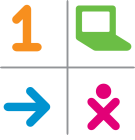Teaching without a teacher in an African village
 Employees of the organization One Laptop Per Child conducted an unusual experiment . They chose two remote villages in Ethiopia, whose population was completely illiterate. In each village there were about twenty children of primary school age. Not one of them has ever been in school and has not seen either books or a computer.
Employees of the organization One Laptop Per Child conducted an unusual experiment . They chose two remote villages in Ethiopia, whose population was completely illiterate. In each village there were about twenty children of primary school age. Not one of them has ever been in school and has not seen either books or a computer.OLPC employees simply brought boxes with Android tablets, on which a set of educational applications was preinstalled, and a solar charging station that several adult villagers were taught to use. There were no instructions in the boxes - nobody could read them anyway. Once a week, an employee came to the village and changed a memory card to which a detailed history of using the tablet was recorded.
Four minutes after the children were left alone with the new toy, one of them was able to turn on the tablet. After five days, on average, each child used 47 applications. Two weeks later, the children sang songs in chorus to memorize the alphabet. After five months, they performed their first “hack”: the ability to change settings was initially blocked on the tablets, and in addition, the camera was turned off by mistake. Children were able to bypass the simple lock, turn on the camera and customize the desktop to your liking.
For several months, they not only did not lose interest in the tablet, but even tried to write the words themselves in a graphic editor. It is not yet clear whether children can learn how to fully read and write without the help of adults. According to the head of the OLPC Nicholas Negroponte, to find out, you need another one and a half to two years.
')
In the world, about one hundred million children are deprived of the opportunity to go to school. Preparing a sufficient number of qualified teachers and building thousands of schools is an incredibly difficult task that is unlikely to be solved in the coming years. OLPC believes that it is easier and more efficient to give children the opportunity to learn independently.
 This approach is called " minimally invasive education ." The first experiment of this kind was conducted by the professor of Newcastle University Sugat Mitra in 1999 in India. An experiment called "Hole in the wall" was that in one of the slums of New Delhi a computer connected to the Internet was built into the wall. Children without any prior training and without the help of adults have learned to use it, have mastered the search engines and e-mail, the basics of the English language, and their grades in school have noticeably improved. Since then, several hundred such public computers have already been installed in India, Cambodia and some African countries.
This approach is called " minimally invasive education ." The first experiment of this kind was conducted by the professor of Newcastle University Sugat Mitra in 1999 in India. An experiment called "Hole in the wall" was that in one of the slums of New Delhi a computer connected to the Internet was built into the wall. Children without any prior training and without the help of adults have learned to use it, have mastered the search engines and e-mail, the basics of the English language, and their grades in school have noticeably improved. Since then, several hundred such public computers have already been installed in India, Cambodia and some African countries.Source: https://habr.com/ru/post/157083/
All Articles